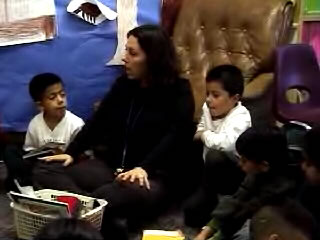Learning from our conversations in English: Using video in the bilingual classroom as a tool for reflection on English language learning and teaching
Sarah
Capitelli, Melrose Elementary School, Oakland CA
with Desiree Pointer, Knowledge Media Lab, The Carnegie
Foundation
How we learned from our conversations in English:
- Overview
- What structures support English language development in my classroom?
- How do conversations between students support English language learning?
- What strategies do good English language learners use?
- How can video be used to give my students a window into their English language learning?
- Next steps
Context
Class Materials
Resources
Overview
I am a 1st/2nd Spanish bilingual teacher in Oakland, California. This snapshot tells part of the story of my inquiry journey in my classroom. The work that is represented here comes in the middle of a longer story that began when I started teaching five years ago and continues as I am learning to become a better teacher and teacher researcher. Since beginning my teaching career I have been concerned with how to best meet the needs of my English language learners (ELL) during English language development (ELD) class. In particular, I am concerned with how to help them create a strong foundation for their learning of English. In my research I have discovered that our school’s program has not worked for the most needy students. For this reason I have continued to study my own ELD practice. This snapshot is an example of my inquiry project last year in my ELD class. My research questions were 1) what structures support communication between students during ELD? and 2) how do conversations impact their English language learning?
Based on
my prior research I structured a new program last year in which I had
a heterogeneous ELD class and organized multiple opportunities for students
to talk with one another in English. The idea guiding this practice was
that by talking with one another, students could help one another learn
to speak English. The more experienced English speakers could assist those
less conversant and in doing so learn more English themselves. Throughout
the process I collected various kinds of data including student work,
narratives of practice and student achievement data. I also experimented
using video data to better understand what was really going on in my students’
conversations. I have included conversations between students, conversations
with colleagues, student work, classroom conversations and my own reflections
on these pieces of text.
As a teacher researcher who is new to using video in her classroom, I
have come to see video as an inquiry tool for both the students and myself
that provides the class with new windows through which to reflect upon
English language learning and teaching. My hope is that this snapshot
will provide others with a window into both my ongoing processes of teacher
inquiry and learning, as well as their own inquiry and learning.
(Note: This site requires the Quicktime and Flash plugins.)
